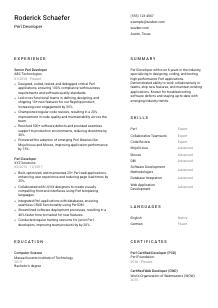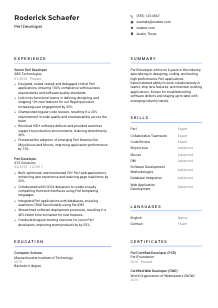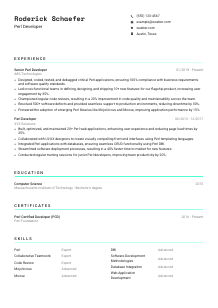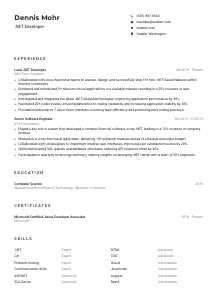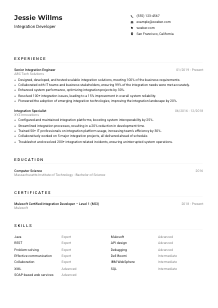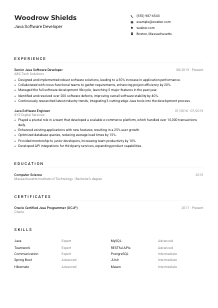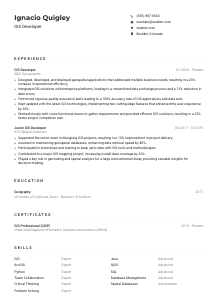Perl Developer Resume Example
Crafting Perl magic, but your resume feels like a syntax error? Browse this Perl Developer resume example, refined with Wozber free resume builder. Realize how to present your perl-ific skills and workaround wisdom to precisely align with job specs, scripting a career that's always on point!
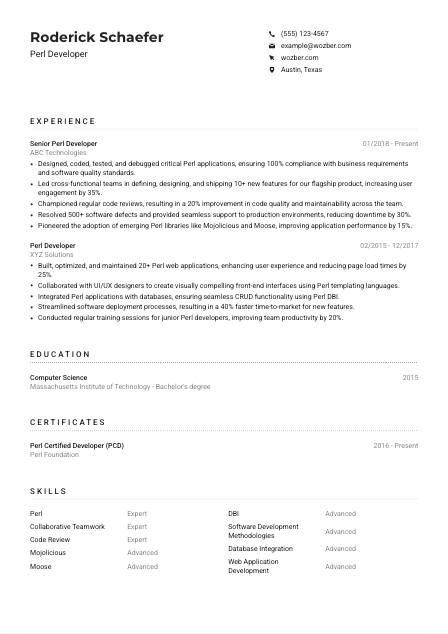
How to write a Perl Developer resume?
Hey there, future Perl Developer maestro! Stepping into the vast world of software development with a focus on Perl is no small feat. Your resume isn't just a piece of paper; it's the code that compiles your career path, and today, you're going to optimize it.
Diving into the Perl Developer realm, this guide, powered by Wozber's free resume builder, will walk you through the art and science of tailoring your resume. From leveraging ATS-friendly resume templates to encoding your resume for ATS optimization, let's script your success story together!
Personal Details
Your Personal Details section is much like the header of your script - it initiates the documentation of your professional journey. Let's format it to pass the 'compile test' with flying colors, ensuring the hiring manager's compiler (a.k.a., their attention) runs smoothly to the rest of your resume.
1. Spotlight Your Name
Think of your name as the class name of your career's codebase – it should be clearly identifiable and stand out. A slightly larger font might just do the trick, making your name the entry point of your professional declaration.
2. Job Title Alignment
Directly beneath your name, declare your specialization with the job title 'Perl Developer'. This not only reflects your area of expertise but also aligns perfectly with the job you're applying for, making it instantly clear what role you're compiled for.
3. Essential Contact Syntax
Your contact information is akin to your method declarations – necessary for the caller (in this case, the hiring manager) to reach out to you. Ensure your phone number and a professional email address are formatted cleanly and checked for errors, much like debugging a script.
4. Location Parameter
Just as important as the environment setup in your Perl scripts, your location matches the job's geo-preference. Including 'Austin, Texas' demonstrates you're in the right execution environment (or willing to migrate to it), fulfilling the job's geographic requirements.
5. Online Profile URLs
In our digital age, consider adding URLs to your professional profiles, akin to adding comments in your code for further reference. This gives hiring managers a 'repository' to view more of your work, expanding their understanding of your capabilities.
Takeaway
With the header of your resume polished and error-free, you've laid down the groundwork for compiling a successful script, a.k.a., your resume. Keep it professional, aligned, and, most importantly, reflective of your proficiency and location. On to the next!





Experience
The Experience section is where your professional script gets interesting. It's where you define your functions, detail your algorithms, and demonstrate the execution of your skills. Tailoring this section to reflect your Perl wizardry is crucial.
- Designed, coded, tested, and debugged critical Perl applications, ensuring 100% compliance with business requirements and software quality standards.
- Led cross‑functional teams in defining, designing, and shipping 10+ new features for our flagship product, increasing user engagement by 35%.
- Championed regular code reviews, resulting in a 20% improvement in code quality and maintainability across the team.
- Resolved 500+ software defects and provided seamless support to production environments, reducing downtime by 30%.
- Pioneered the adoption of emerging Perl libraries like Mojolicious and Moose, improving application performance by 15%.
- Built, optimized, and maintained 20+ Perl web applications, enhancing user experience and reducing page load times by 25%.
- Collaborated with UI/UX designers to create visually compelling front‑end interfaces using Perl templating languages.
- Integrated Perl applications with databases, ensuring seamless CRUD functionality using Perl DBI.
- Streamlined software deployment processes, resulting in a 40% faster time‑to‑market for new features.
- Conducted regular training sessions for junior Perl developers, improving team productivity by 20%.
1. Parsing Job Requirements
Your first task is to understand the 'job script' requirements. Look for keywords and duties in the job description and think about how your past roles fulfill these requirements. This step ensures you're on the right track to meet the hiring manager's expectations.
2. Functions of Your Roles
Structure your experience in a way that clearly presents the 'functions' of your career - your roles and projects. Like defining a subroutine in Perl, outline your positions, the companies, and the dates, showcasing a chronological path of your development experience.
3. Scripting Accomplishments
Detail your responsibilities and achievements like well-commented code blocks, making it easy for the reader to understand your impact. Use the job description to highlight specific experiences, such as your work with 'Mojolicious' and 'Moose', directly relating to the role's requirements.
4. Quantify Your Impact
Numbers in your experience section act like performance metrics in your code, offering tangible proof of your efficiency and impact. Whenever possible, quantify your achievements, such as 'improving application performance by 15% with Mojolicious and Moose'.
5. Relevant Experiences Only
Just like you wouldn't clutter your Perl modules with unnecessary subroutines, keep your resume free of irrelevant experiences. Sharp and targeted entries allow for a cleaner read and a more impressive impact.
Takeaway
Approach your Experience section with the mindset of a Perl developer – with precision, relevance, and clear demonstrations of your capabilities. Each bullet point is a testament to your coding prowess and your potential fit for the Perl Developer role.
Education
The Education section of your resume, much like the libraries you import in Perl, provides the foundation upon which your skills are built. Let's align it with the job's demands, underscoring your relevant academic background.
1. Degree Declaration
First off, identify the 'lib' requirements of the job – i.e., the education qualifications. For our Perl Developer role, a 'Bachelor's degree in Computer Science' is a must. Make sure this is clearly stated, proving you've got the foundational 'modules' installed.
2. Educational Syntax
Keep this section readable and straightforward. Like structuring a Perl program, list the degree, field of study, institution, and graduation date in a clean, organized manner. Simplicity is key for easy comprehension and to show you meet the basic requirments.
3. Degree Specifications
Highlighting your specific degree and field of study is crucial, especially if it directly matches the job requirements. For roles demanding a robust understanding of software development principles, your Computer Science degree is a keyword that shouldn't be overlooked.
4. Relevant Academic Highlights
If there are courses, projects, or achievements particularly pertinent to Perl development or the job's technical requirements, this is the place to list them. However, keep in mind the level of the position – for more experienced roles, emphasize professional achievements over academic ones.
5. Additional Academic Credentials
Were you a part of a coding club, or did you lead a significant project relevant to Perl development? This section can also shed light on your ability to collaborate and lead, important soft skills that complement your technical prowess.
Takeaway
Your education section reflects your academic foundation, much like the core libraries in a Perl script. It underpins your technical capabilities and prepares you for the complex problem-solving the role demands. Craft it with clarity, highlighting your academic achievements with relevance to your Perl journey.
Certificates
In the world of Perl development, certain 'modules' or certifications can set you apart, showcasing your dedication to your craft and your eagerness to stay on the cutting edge of technology.
1. Relevant Module Imports
Start by identifying certifications that resonate with the job's technical requirements. While the job description for our Perl Developer position didn't specify certifications, showcasing relevant ones like 'Perl Certified Developer' signals your commitment to the profession.
2. Selective Inclusions
Choose to list certifications that directly complement the role's requirements or enhance your expertise in Perl development. This selective approach ensures hiring managers see the most relevant information first, much like importing essential modules in a Perl script.
3. Expiry and Acquisition Dates
For certifications with validity periods, or if they're a recent achievement, including dates can be a mark of your current knowledge and dedication. Much like documenting the version of a Perl module you're proficient with, this keeps your resume current and credible.
4. Continuous Learning
The tech world evolves rapidly, and so should you. Continuously update your certifications and pursue new learning opportunities, keeping your 'Perl module library' rich and up-to-date. This demonstrates an ongoing commitment to your professional development.
Takeaway
Your certificates are like specialized modules you've added to your Perl toolkit – they showcase your specialized knowledge and ongoing commitment to learning. Highlight them with precision, ensuring they underscore your fit for the Perl Developer role.
Skills
Your Skills section is like declaring the variables and functions that make your professional programming unique. Here, we'll specifically tailor this section to showcase your prowess in Perl and your ability to fulfil the role's technical and collaborative demands.
1. Extract Function Signatures
Carefully read through the job description and identify both explicit and implicit skills required. Understanding the 'syntax' and 'semantics' of the job allows you to match these with your own, emphasizing your compatibility with the role.
2. Prioritized Declarations
Once you've identified the skills needed, list them in a way that highlights your proficiency in critical areas. For a Perl Developer, this means emphasizing expertise in 'Perl', 'Mojolicious', 'Moose', and 'DBI', alongside soft skills such as 'Collaborative Teamwork' and 'Code Review'.
3. Concise and Organized
Keep your skills section organized and focused. Overcrowding it with every skill under the sun can overwhelm the reader, much like an overloaded function. Prioritize clarity and relevance, ensuring the hiring manager can quickly ascertain your fitness for the role.
Takeaway
Just like well-written code, your Skills section should be clean, efficient, and purposeful, clearly showcasing your expertise in the Perl landscape. Keep honing these skills, as each one adds value to your professional 'script' and enhances your candidacy for the Perl Developer role.
Languages
In today's global job market, the ability to communicate in multiple languages can significantly enhance your professional profile, much like localizing a software product to fit different markets. Let's explore how to effectively present your linguistic abilities.
1. Job Description Review
Start by checking if the job posting specifies any language requirements. For this Perl Developer role, proficiency in English is a must. Make sure to list this at the top of this section to immediately address one of the key prerequisites.
2. Highlight Essential Languages
Prioritize your language skills based on the job's requirements and the business context. Listing 'English: Native' directly meets the job's needs, reinforcing your ability to thrive in the role's environment.
3. Additional Linguistic Abilities
Additional languages can be an asset, showcasing your capability to communicate across diverse teams or with international stakeholders. Even if not explicitly required, they add depth to your profile, much like adding useful libraries to a project.
4. Honesty in Proficiency
Clarity about your level of fluency is crucial to setting correct expectations, akin to correctly documenting a function's capabilities. Whether 'Native', 'Fluent', 'Intermediate', or 'Basic', being transparent about your proficiency ensures no misinterpretations.
5. Scope of the Role
Consider how your language skills align with the role's broader context. If the position engages with multinational teams or clients, showcasing your linguistic versatility becomes even more relevant, like offering multilingual support in an application.
Takeaway
Your language skills, while maybe not the main function of your professional script, play a supportive role in illustrating your ability to navigate and adapt in a globalized workplace. Flaunt your linguistic capabilities with pride and consider them a bonus feature of your professional package.
Summary
Just like a function's docblock, your Summary gives an overview of what to expect from your resume – it sketches out your professional identity in a concise, compelling manner. Let's ensure it captures the essence of your capabilities and alignment with the role.
1. Breaking Down the Job Specs
Begin by internalizing the job specifications. Unpack the given requirements and responsibilities to grasp what the job fundamentally entails. This will guide you in sketching a profile that mirrors what the employer is searching for.
2. Opening Declaration
Start with a punchy, clear statement that encapsulates your professional standing and areas of expertise – think of it as introducing the 'main()' function of your career. 'Perl Developer with over 6 years in the industry' sets the tone and framework.
3. Highlight Your Functions
Elaborate on your key skills and accomplishments, focusing on those that directly correspond with the job's requirements. 'Specializing in designing, coding, and testing high-performance Perl applications' directly addresses the needs of the role.
4. Condense your Script
Maintain brevity and impact by distilling your professional essence into 3-5 lines. Like a clean, efficient script, your Summary should pack a punch, leaving the hiring manager eager to read more about your professional saga.
Takeaway
Your Summary section is your chance to make a strong, immediate impression. It's where you showcase your match for the Perl Developer role right off the bat. Reflect, articulate, and distill your professional journey here, persuading the hiring manager to dive deeper into your career narrative.
Launching Your Perl Developer Quest
Congratulations on completing the comprehensive guide to assembling your Perl Developer resume! With each section meticulously tailored to reflect your fit for the role, you're now ready to compile and put your application into action. Remember, your resume is a dynamic document that evolves with you.
Make use of Wozber's free resume builder, including ATS-friendly resume templates and ATS resume scanner for keywords optimization, to keep your resume not just up-to-date, but aligned and powerful. Here's to coding your way into your next career milestone!

- Bachelor's degree in Computer Science, Engineering, or a related field.
- Minimum of 4 years of professional experience in Perl development.
- Strong proficiency in Perl, with a clear understanding of Perl best practices.
- Experience with Perl libraries such as Mojolicious, Moose, and DBI.
- In-depth knowledge of software development methodologies and the ability to work collaboratively in a team environment.
- Must be highly proficient in English.
- Must be located in or willing to relocate to Austin, Texas.
- Design, code, test, and debug Perl applications ensuring software meets business requirements and software quality standards.
- Collaborate with cross-functional teams to define, design, and ship new features and maintain existing applications.
- Participate in code reviews, provide and receive constructive feedback to ensure code quality and maintainability.
- Troubleshoot software defects and support production environments.
- Stay up-to-date with emerging industry trends and technologies to ensure the company remains competitive in the market.





